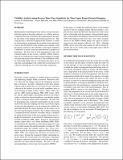| dc.contributor.author | Shabelansky, Andrey Hanan | |
| dc.contributor.author | Malcolm, Alison E. | |
| dc.contributor.author | Fehler, Michael | |
| dc.contributor.other | Massachusetts Institute of Technology. Earth Resources Laboratory | |
| dc.date.accessioned | 2014-09-30T12:06:02Z | |
| dc.date.available | 2014-09-30T12:06:02Z | |
| dc.date.issued | 2011 | |
| dc.identifier.uri | http://hdl.handle.net/1721.1/90451 | |
| dc.description.abstract | Identifying the relationship between surface seismic data and a particular region in the earth, referred to as visibility analysis, is important because it facilitates the optimization of the quality and speed of the imaging and monitoring processes. This study presents a data-driven approach that estimates a visibility relationship by propagating the recorded seismic data backward in time through the entire medium and coupling it with the region of interest in the subsurface. The region of interest is defined by a specific time-lapse perturbation in geophysical parameters. We show that by back-propagating in time only a limited number of shot records, a reliable visibility relationship can be established for target-oriented imaging of changes in a particular region in the subsurface. The established visibility relationship implies that in a subsequent time-lapse survey, only data corresponding to the visible shot records need to be collected, reducing the costs of the time-lapse acquisitions. | en_US |
| dc.description.sponsorship | TOTAL (Firm) | en_US |
| dc.language.iso | en_US | en_US |
| dc.publisher | Massachusetts Institute of Technology. Earth Resources Laboratory | en_US |
| dc.relation.ispartofseries | Earth Resources Laboratory Industry Consortia Annual Report;2011-10 | |
| dc.subject | Imaging | |
| dc.subject | Modeling | |
| dc.title | Visibility Analysis using Reverse Time Wave Sensitivity for Time-Lapse Target-Oriented Imaging | en_US |
| dc.type | Technical Report | en_US |
